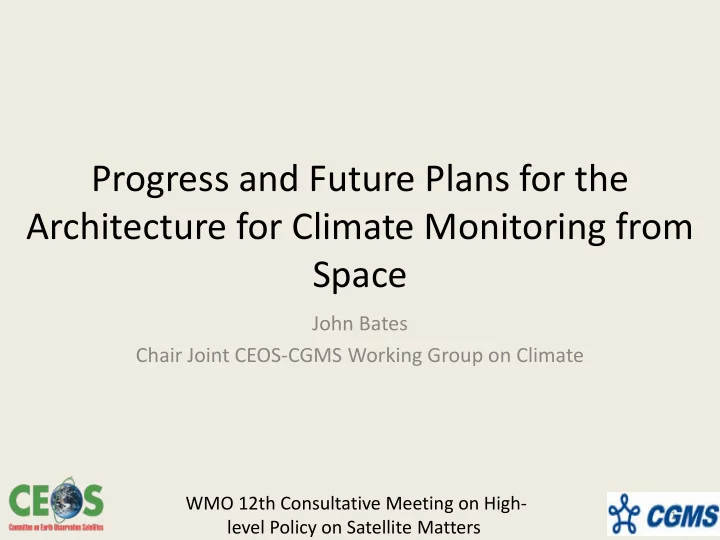

Progress and Future Plans for the Architecture for Climate Monitoring from Space John Bates Chair Joint CEOS-CGMS Working Group on Climate WMO 12th Consultative Meeting on High- 1 level Policy on Satellite Matters
Outline • The climate monitoring architecture strategy forms the basis for moving forward to achieve the goals of the Working Group on Climate (WGClimate) • The architecture allows for participation of agencies across a broad range of time scales and societal applications • I invite WMO members to help work in areas that benefit both their agencies and the broader climate community WMO 12th Consultative Meeting on High- 2 level Policy on Satellite Matters
Logical Architecture 4 Pillars WMO 12th Consultative Meeting on High- 3 level Policy on Satellite Matters
Logical Architecture – Data Flow WMO 12th Consultative Meeting on High- 4 level Policy on Satellite Matters
Architecture – Latency/Application View WMO 12th Consultative Meeting on High- 5 level Policy on Satellite Matters
Implementation – Capturing the Physical Climate Monitoring Architecture • The Logical Architecture views provide a generic flow applicable to all Agencies • The Physical Architecture is needed to Stewardship CEOS ECV & Maturity capture the ‘as is’ and ‘to be’ systems Inventory Index actually being used • The Physical Architecture is being documented by conducting an Essential Climate Variable (ECV) Inventory ECV • Results of the ECV Inventory will then Architecture Assessments be used to assess completeness and maturity of ECVs WMO 12th Consultative Meeting on High- 6 level Policy on Satellite Matters
WGClimate Work Plan • WGClimate was the trial Working Group for the new form of the CEOS-CGMS 3-year Work Plan • Work Plan elements implement WGClimate objectives in sequential order • Activities include Climate Monitoring, Research, and Services (CMRS) • Coordinate development of Climate Data Records (CDRs) and related datasets addressing Essential Climate Variables (ECVs) established by the Global Climate Observing System (GCOS) • Continue cooperation with Group on Earth Observations (GEO), Global Climate Observing System (GCOS), and the World Meteorological Organization (WMO), in the development of a space- based system to support climate information and adaptation. WMO 12th Consultative Meeting on High- 7 level Policy on Satellite Matters
WGClimate Work Plan – Climate Monitoring, Research, and Services The first 3 CMRS activities form an iterative cycle, acknowledged in the last • CMRS activity – • CMRS- 1: ECV inventory (first version) – Tools needed are available • CMRS-2 : Gap analysis (first version) – Identify several target ECVs and conduct analysis • CMRS-3 : Action plan (first version) – Identify actions Space Agencies can take to mitigate any gaps CMRS-9 : Update of ECV inventory, gap analysis and action plan (version 2) • – The above sequence forms the basis for an ongoing analysis cycle, in agreement with the new GCOS plans WMO 12th Consultative Meeting on High- 8 level Policy on Satellite Matters
WGClimate Work Plan – Climate Monitoring, Research, and Services • The next two CMRS activities seek to assure that climate products are connected to user applications and decision support • CMRS-4 : Case studies linking CDRs to societal applications and informed policy decisions – Identify examples from current work and map it to the Climate Monitoring Architecture • CMRS-5 : Contributions to the Global Framework for Climate Services (GFCS) – Work to identify existing examples of Climate Services that can be applied or adapted to the GFCS focus areas WMO 12th Consultative Meeting on High- 9 level Policy on Satellite Matters
WGClimate Work Plan – Climate Monitoring, Research, and Services • The final three elements identify important interactions with external communities • CMRS-6 : Report to UNFCCC Subsidiary Body for Scientific and Technological Advice-Research and Systematic Observation (SBSTA-RSO CMRS-7: Report to GCOS implementation plan activities • accomplished by Space Agencies on climate observations • CMRS-8 : Incorporation of in situ data holdings within the ECV inventory – reuse original ECV questionnaire framework. Data base analysis and follow up will not be done by CEOS WMO 12th Consultative Meeting on High- 10 level Policy on Satellite Matters
Conclusions • CEOS, CGMS, and WMO have agreed to an architecture for climate monitoring from space • The logical architecture provides a generic framework for a physical architecture • The physical architecture is being captured in an Essential Climate Variable inventory • The steps in populating the ECV inventory are captured in a Work Plan for 2014-2016 for the Joint CEOS-CGMS Working Group on Climate WMO 12th Consultative Meeting on High- 11 level Policy on Satellite Matters
Recommend
More recommend